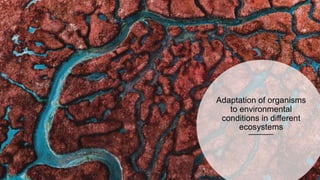
adaptation.pptx
- 1. Adaptation of organisms to environmental conditions in different ecosystems
- 2. Adaptations • The survival of each population depends on an organism’s capacity to adapt to changes in the ecosystem it inhabits. • Morphologic adaptations • Camouflage: hid in plain sight and tricking their enemies. For example, an insect can mimic color and shape of a leaf in an eco-system • Mimicry: resemble other organisms and their own environment to survive. For example, An insect that is equal to a leaf.
- 3. Structures that depend on their environment • In the wáter: developed respiratory organs or fishes on deep Waters, • Adaptations to diverse temperatures: • Cold ecosystems: The animals that live in very cold places retain fat under their skin. • Warm ecosystems: Elephants use their ears as a fan that helps them keep cool. Camels have a hump where water is stored between layers of fat.
- 4. Adaptations in plants • Temperature • Cold: some annual plants only preserve the most resistant organs • seed repositories • buds or shoots • shed all their leaves (Guayacán) • decrease their growth. • Warm: to accumulate water and to cover their structures so they can avoid dehydration by exposure to extreme solar radiation
- 5. Adaptations to light 1. Trees 2. Bushes 3. Plants such as vines 4. Epiphytes 5. Herbaceous layer
- 6. Adaptations to food • Every animal has its own specific physical structures to extract, masticate, or chew food, ingesting and digesting food to obtain their nutrients. Their characteristics are related to specific functions of their digestive system.
- 7. Carnivores • meat-eating animals • Mammals have short, sharp teeth to kill and tear the meat from their prey. • Reptiles such as the crocodile also have sharp teeth. • Carnivorous fish have rows of sharp teeth. • Carnivorous birds do not have teeth but have curved and strong beaks.
- 8. Herbivores • Herbivorous mammals have molars which are wider in order to break and crush food. For example: horses, cattle and rhinoceroses. • Besides using jaws and teeth to bite, other animals such as anteaters and frogs use adapted tongues to capture food • Herbivorous birds. Their claws are less developed than those of carnivorous birds. Their beaks also have different shapes and structures to facilitate the eating of plants, seeds and flowers
- 9. Omnivores • Animals that are both carnivorous and herbivorous • Omnivores have teeth, fangs and molars to crush and tear their food like monkeys do